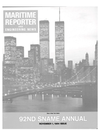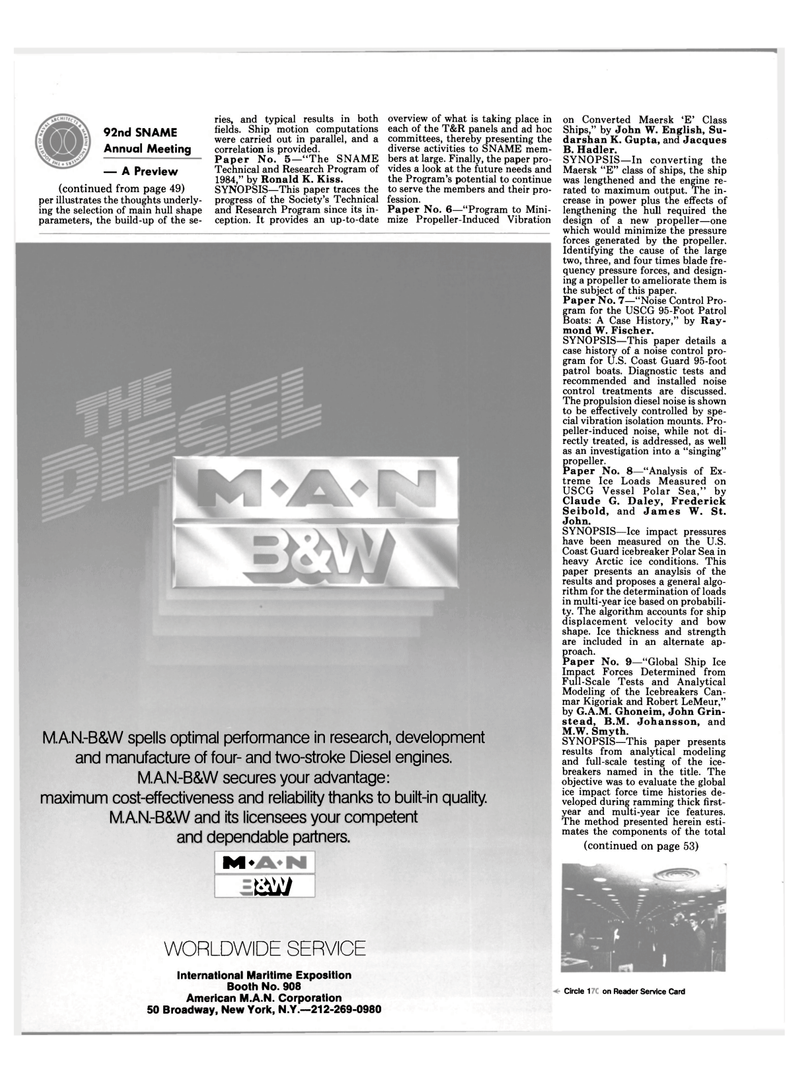
Page 46: of Maritime Reporter Magazine (November 1984)
Read this page in Pdf, Flash or Html5 edition of November 1984 Maritime Reporter Magazine
92nd SNAME
Annual Meeting — A Preview (continued from page 49) per illustrates the thoughts underly- ing the selection of main hull shape parameters, the build-up of the se- ries, and typical results in both fields. Ship motion computations were carried out in parallel, and a correlation is provided.
Paper No. 5—"The SNAME
Technical and Research Program of 1984," by Ronald K. Kiss.
SYNOPSIS—This paper traces the progress of the Society's Technical and Research Program since its in- ception. It provides an up-to-date overview of what is taking place in each of the T&R panels and ad hoc committees, thereby presenting the diverse activities to SNAME mem- bers at large. Finally, the paper pro- vides a look at the future needs and the Program's potential to continue to serve the members and their pro- fession.
Paper No. 6—"Program to Mini- mize Propeller-Induced Vibration
M.A.N.-B&W spells optimal performance in research, development and manufacture of four- and two-stroke Diesel engines.
M.A.N.-B&W secures your advantage: maximum cost-effectiveness and reliability thanks to built-in quality.
M.A.N.-B&W and its licensees your competent and dependable partners.
M* t^J
WORLDWIDE SERVICE
International Maritime Exposition
Booth No. 908
American M.A.N. Corporation 50 Broadway, New York, N.Y.—212-269-0980 on Converted Maersk 'E' Class
Ships," by John W. English, Su- darshan K. Gupta, and Jacques
B. Hadler.
SYNOPSIS—In converting the
Maersk "E" class of ships, the ship was lengthened and the engine re- rated to maximum output. The in- crease in power plus the effects of lengthening the hull required the design of a new propeller—one which would minimize the pressure forces generated by the propeller.
Identifying the cause of the large two, three, and four times blade fre- quency pressure forces, and design- ing a propeller to ameliorate them is the subject of this paper.
Paper No. 7—"Noise Control Pro- gram for the USCG 95-Foot Patrol
Boats: A Case History," by Ray- mond W. Fischer.
SYNOPSIS—This paper details a case history of a noise control pro- gram for U.S. Coast Guard 95-foot patrol boats. Diagnostic tests and recommended and installed noise control treatments are discussed.
The propulsion diesel noise is shown to be effectively controlled by spe- cial vibration isolation mounts. Pro- peller-induced noise, while not di- rectly treated, is addressed, as well as an investigation into a "singing" propeller.
Paper No. 8—"Analysis of Ex- treme Ice Loads Measured on
USCG Vessel Polar Sea," by
Claude G. Daley, Frederick
Seibold, and James W. St.
John.
SYNOPSIS—Ice impact pressures have been measured on the U.S.
Coast Guard icebreaker Polar Sea in heavy Arctic ice conditions. This paper presents an anaylsis of the results and proposes a general algo- rithm for the determination of loads in multi-year ice based on probabili- ty. The algorithm accounts for ship displacement velocity and bow shape. Ice thickness and strength are included in an alternate ap- proach.
Paper No. 9—"Global Ship Ice
Impact Forces Determined from
Full-Scale Tests and Analytical
Modeling of the Icebreakers Can- mar Kigoriak and Robert LeMeur," by G.A.M. Ghoneim, John Grin- stead, B.M. Johansson, and
M.W. Smyth.
SYNOPSIS—This paper presents results from analytical modeling and full-scale testing of the ice- breakers named in the title. The objective was to evaluate the global ice impact force time histories de- veloped during ramming thick first- year and multi-year ice features.
The method presented herein esti- mates the components of the total (continued on page 53)
Circle 301 on Reader Service Card

 45
45

 47
47
